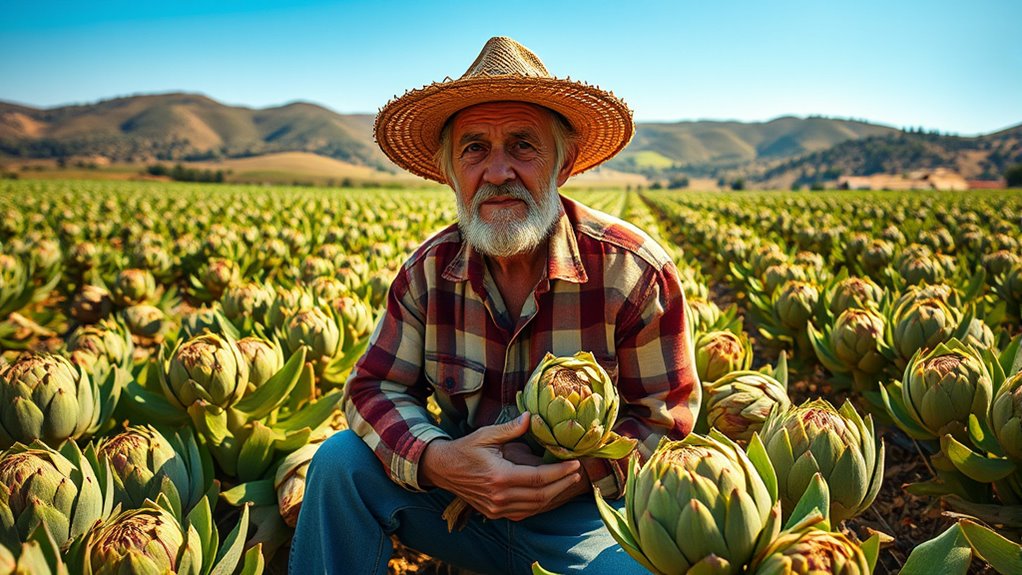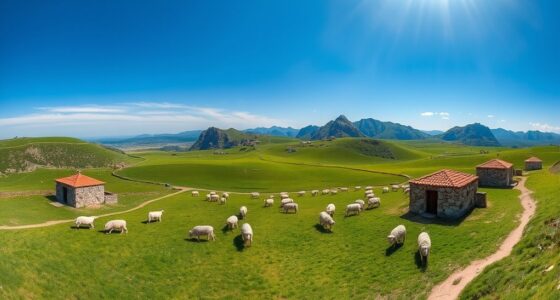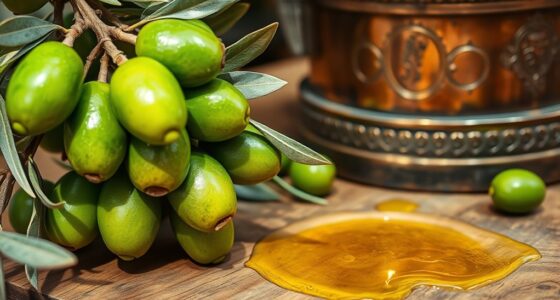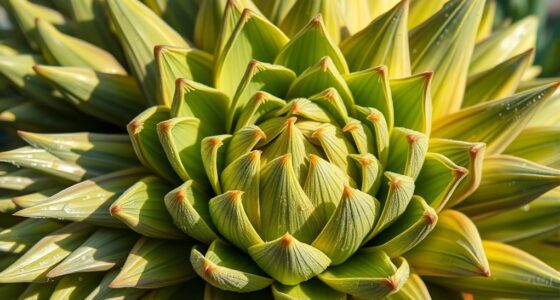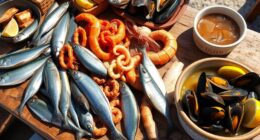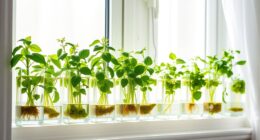Talking with a Sardinian artichoke farmer reveals a deep connection to a centuries-old tradition. They carefully select soils, use organic techniques, and harvest at just the right time to meet PDO standards. The farmer shares how manual labor, strict regulations, and seasonal challenges shape their work. You’ll discover how this age-old cultivation preserves heritage while facing modern hurdles. Stay with us, and you’ll uncover more about their dedication and the future of Sardinian artichokes.
Key Takeaways
- Sardinian artichoke farming has deep historical roots, dating back centuries and linked to regional traditions and microclimate advantages.
- Cultivation requires specific land management, including organic-rich soil, mulching, and careful planting to optimize growth.
- Harvesting occurs from mid-October to February, focusing on buds that are fully formed but unopened, using manual techniques.
- Strict PDO standards ensure product quality, emphasizing manual harvesting, proper packaging, and traceability to maintain authenticity.
- Challenges include high labor costs, environmental threats, and market fluctuations, but opportunities lie in exports and sustainable practices.
The Heritage of Sardinian Artichoke Cultivation
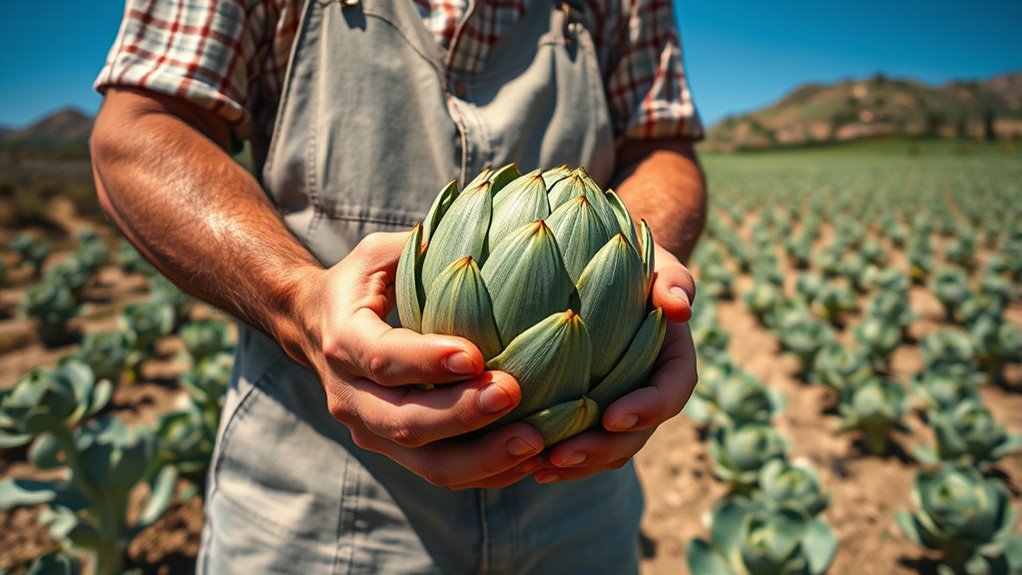
The heritage of Sardinian artichoke cultivation spans centuries of tradition, blending ancient origins with regional adaptations. You’re part of a legacy that dates back to the Egyptians and Greeks, who first documented its use. The Romans further cultivated it, and the Phoenicians introduced it to Sardinia. Over time, local farmers embraced it, making it a crucial part of the island’s farming culture. Historical records from figures like Don Andrea Manca dell’Arca highlight its economic importance since the 18th century, while early 20th-century expansion marked a turning point. The Sardinian prickly artichoke’s unique traits, linked to the island’s microclimate, have cemented its cultural significance. Today, this history continues to shape its role in local cuisine and regional identity, emphasizing the importance of biodiversity in maintaining its distinctive qualities.
Cultivation Techniques and Land Management
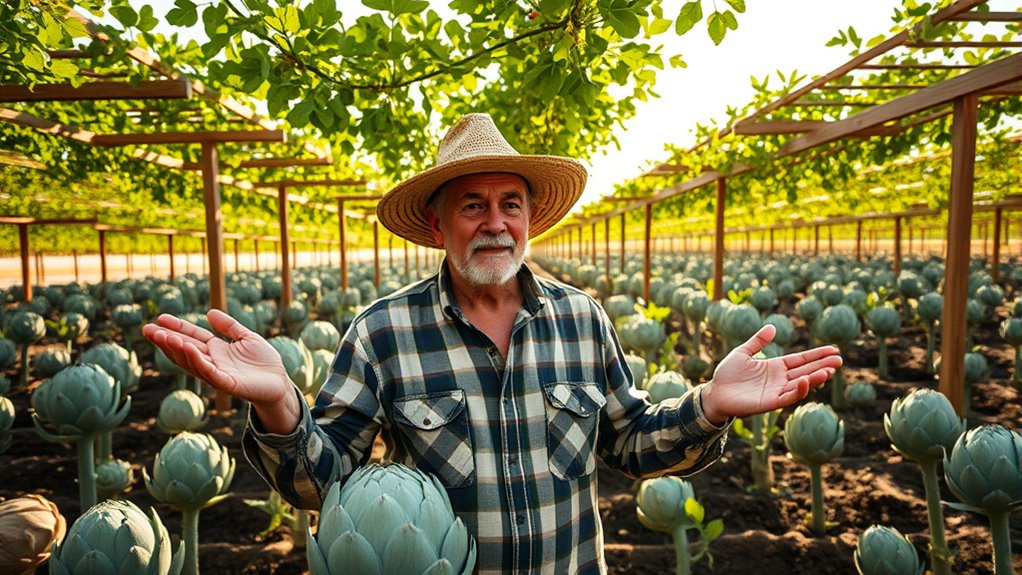
Building on the rich history of Sardinian artichoke cultivation, mastering effective land management and cultivation techniques guarantees healthy growth and high yields. You should prepare deep, fertile, well-draining loam enriched with organic matter, removing weeds beforehand to reduce competition. Incorporate two bucketfuls of compost per square meter to improve soil structure and fertility, and adjust pH to near-neutral levels. Regular mulching helps retain moisture, insulate roots, and suppress weeds. When planting, space seedlings 18 inches apart in sunny, sheltered spots, planting seeds 10-12 weeks before frost. Use consistent deep watering—1-2 inches weekly—and fertilize with organic compost and slow-release nutrients. Protect plants from frost with mulching and shelter, and monitor pests diligently to maintain vigor and maximize yield. Additionally, understanding angel numbers related to growth and transformation can inspire a mindful approach to nurturing your crops and personal development.
Harvesting Practices and Timing
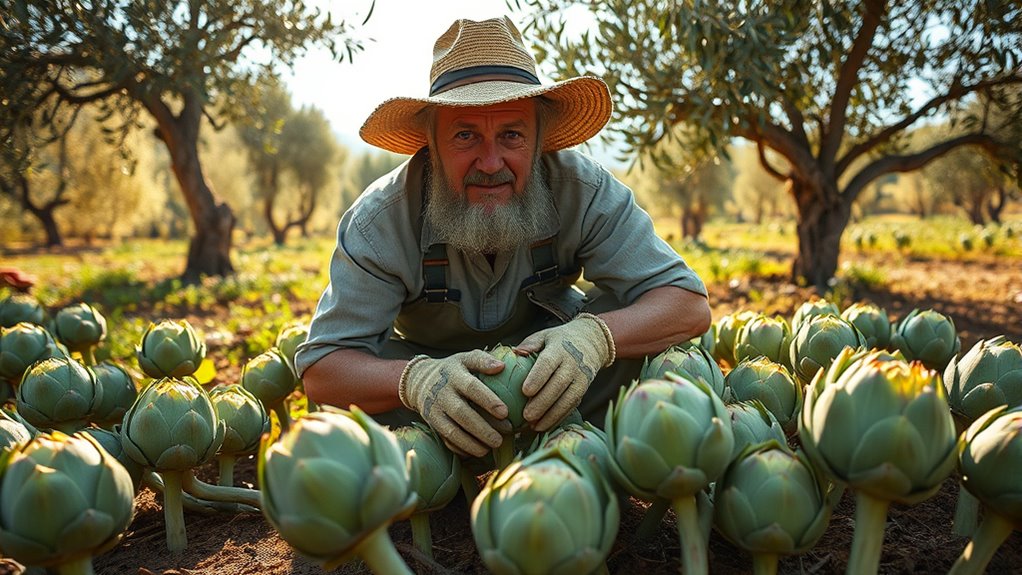
Timing your Sardinian artichoke harvest is crucial to guarantee peak flavor and quality. You want to pick the buds when they reach full size but before the bracts open or flowers form. Look for a firm, fleshy head with tightly closed bracts, often with purple hues on Sardinian varieties. The stem should be about 8 centimeters long, with the base bracts tender yet crunchy, balancing bitterness and sweetness. Harvest when the buds are at their prime, typically from mid-October to February, depending on your climate. Use sharp shears or a knife to cut the bud along with a short stem, ensuring minimal damage. Harvest smaller side shoots too, as they tend to be sweeter and more tender, maximizing your crop’s quality. Proper harvesting techniques help prevent plant stress and encourage future growth. Proper timing combined with accurate maturity assessment ensures the best flavor and crop yield.
Maintaining Product Quality and PDO Standards
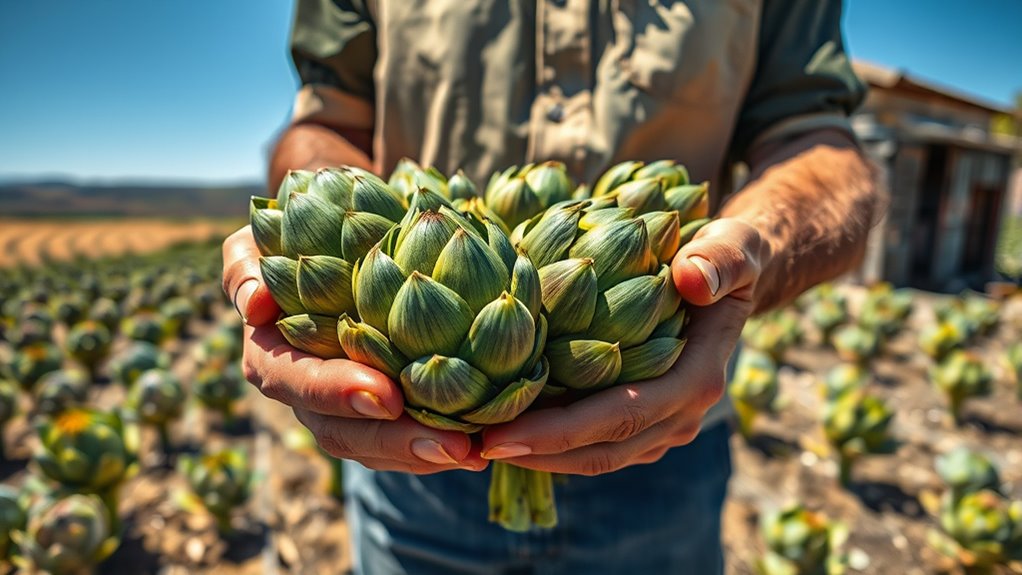
Maintaining product quality and adhering to PDO standards require strict attention to cultivation, harvesting, and handling practices. You must follow precise guidelines to preserve authenticity and freshness. Use only soils specific to Sardinian zones, ensuring the unique nutrients shape the artichoke’s flavor and texture. Harvest manually at the right time, cutting stems before bracts open to keep the product pristine. Package immediately after harvest, sealing to prevent oxidation, contamination, and to extend shelf life. Ensure traceability with numbered packaging, so every step can be verified, maintaining consumer trust and PDO compliance. Additionally, proper storage conditions are essential to prevent deterioration and ensure the product retains its high quality during transportation and sale. Implementing certified handling practices also helps meet regulatory standards and supports sustainable farming methods.
Challenges Facing Sardinian Artichoke Farmers
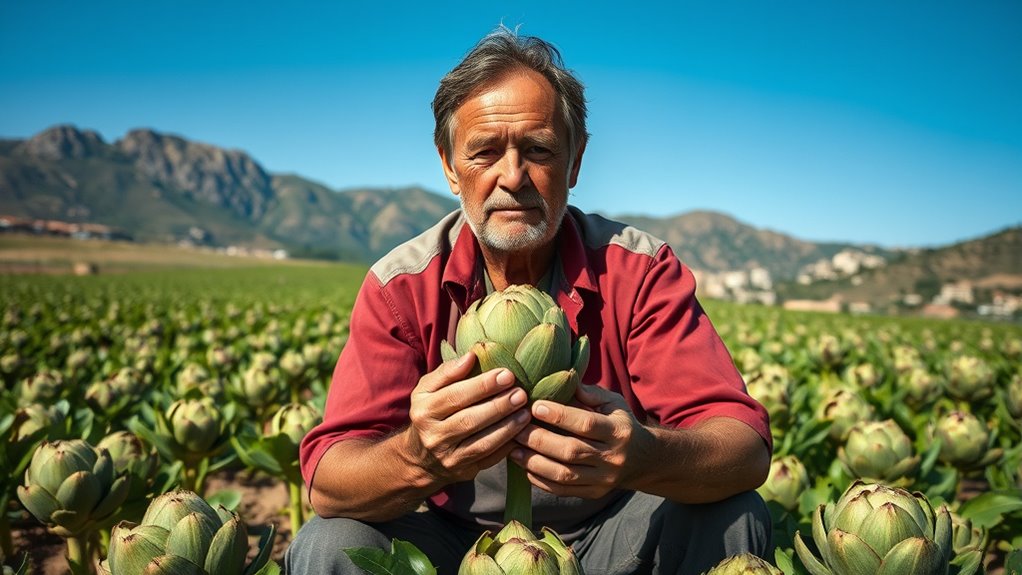
Sardinian artichoke farmers face a complex array of challenges that threaten their productivity and sustainability. High labor costs, driven by the manual work needed for planting and harvesting, push up expenses and limit profit margins. Market demand fluctuations and stiff competition from other regions and countries make price stability difficult, while complex regulations hinder efficient access to markets. Limited investment in organic farming restricts growth toward sustainable practices. Environmental issues like droughts, irregular rainfall, pests, and disease pressures also threaten yields. The terrain’s nature limits mechanization, keeping labor costs high. Additionally, reliance on a few key crops exposes farmers to price shocks. Rural depopulation affects labor availability, and limited financial support hampers modernization efforts, compounding these ongoing struggles. Despite these difficulties, the regional initiatives aimed at promoting organic cultivation and sustainable practices could offer new opportunities for resilience and growth in the future. Moreover, understanding the currency fluctuations and their impact on export competitiveness can help farmers plan better for future market changes.
The Future of Artichoke Farming in Sardinia

Despite the challenges facing Sardinian artichoke farmers, opportunities for growth and innovation are emerging on the horizon. You can expect expanded customer bases, with plans to supply more buyers by January, increasing market stability. Technological advancements hold promise for better water management and higher yields, helping to address water scarcity. There’s also a strong focus on sustainability, aiming to preserve soil health and reduce environmental impacts. Additionally, export opportunities are opening up, as European demand continues to grow and new markets emerge. Market shortages during the festive season underscore the need for strategic planning and innovation. Here’s what you should look forward to: 1. Increased exports to international markets 2. Adoption of eco-friendly farming practices 3. Improved crop management through technology 4. Greater resilience against climate change challenges, including sustainable agriculture initiatives.
Frequently Asked Questions
How Does Climate Change Impact Your Annual Harvest?
You notice that climate change affects your annual harvest in many ways. Rising temperatures shorten flowering periods and reduce yields, while unpredictable rainfall causes drought stress. Warmer nights and heat stress lower head size and quality. Pest and disease pressures increase, and water scarcity forces you to optimize irrigation. Soil health also suffers, making it harder to maintain a consistent, high-quality harvest year after year.
What Traditional Methods Do You Still Use in Cultivation?
You still depend on traditional cultivation methods like deep plowing in May and June, manual planting, and transplanting shoots from dormant plants. Weed control is done by hand, and irrigation is carefully managed after second plowing. You harvest artichokes by hand, cutting stems at specific points to ensure quality. Propagation mainly involves suckers and rhizome parts, maintaining regional heritage and biodiversity, which are key to your farm’s sustainability.
How Do You Ensure Pest Control Without Chemicals?
You guarantee pest control without chemicals by embracing biological, cultural, and physical methods. You introduce parasitic wasps and encourage natural predators like lady beetles and lacewings. You remove crop residue, use diatomaceous earth, and reinforce physical barriers. Regular monitoring helps you apply organic treatments like neem oil and horticultural soaps. You keep the environment clean and use water sprays or hand-picking to physically remove pests, maintaining healthy artichoke crops sustainably.
What Role Does Community Play in Your Farming Practices?
Community plays a crucial role in your farming practices by providing shared resources, knowledge, and support. You rely on local cooperatives for collective marketing, maintaining quality standards, and adopting sustainable techniques. Through workshops and peer support, you learn eco-friendly methods that protect soil and water. Strong community ties help you access broader markets, preserve traditional practices, and reinforce cultural identity, ensuring your farm’s resilience and the continuation of Sardinian artichoke heritage.
How Do Seasonal Variations Affect Artichoke Flavor and Quality?
Imagine walking through a lush garden, where seasonal shifts shape every leaf. You’ll notice that spring’s cooler temps make your artichokes tender and sweet, perfect for raw dishes. As summer warms, bitterness rises, and texture toughens, requiring longer cooking. These variations influence flavor and quality, so you harvest at just the right moment. By aligning your practices with nature’s rhythm, you guarantee your artichokes maintain their vibrant taste and perfect texture.
Conclusion
So, next time you enjoy a Sardinian artichoke, remember, it’s not just a tasty veggie but a symbol of centuries of dedication—crafted through patience, tradition, and a few pesky challenges. Who knew that such a thorny plant could carry so much history? Maybe, just maybe, the secret to its charm is that it’s been fighting the odds all along—making every bite a small victory worth savoring. Bon appétit to resilience, indeed!
